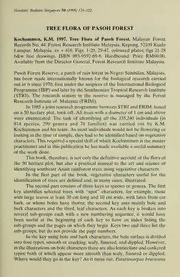Table Of ContentGardens'BulletinSingapore50 (1998) 121-122.
TREE FLORA OF PASOH FOREST
Kochummen, K.M. 1997. Tree Flora of Pasoh Forest. Malayan Forest
Records No. 44. Forest Research Institute Malaysia, Kepong, 52109 Kuala
Lumpur, Malaysia, xv + 416. Figs. 1-20, 29-42, coloured plates; figs 21-28
b&w line drawings. ISBN 983-9592-69-6. Hardbound. Price RM60.00.
Available from the Director General, Forest Research Institute Malaysia.
Pasoh Forest Reserve, a patch of rain forest in Negeri Sembilan, Malaysia,
has been made internationally known for the biological research carried
out in it since 1970, first under the auspices of the International Biological
Programme (IBP) and later by the Smithsonian Tropical Research Institute
(STRI). The research station in the reserve is managed by the Forest
Research Institute of Malaysia (FRIM).
In 1985 ajoint research programme between STRI and FRIM, based
on a 50 hectare plot, took off. All trees with a diameter of 1 cm and above
were enumerated. The task of identifying all the 335,240 individuals (in
814 species, 290 genera and 78 families) was carried out by K.M.
Kochummen and his team. As most individuals would not be flowering or
fruiting at the time ofsample, they had to be identified based on vegetative
characters. This required a special skill ofwhich Kochummen is the master
practitioner and in this publication he has made available a useful summary
of the work done.
This book, therefore, is not only the definitive account of the flora of
the 50 hectare plot, but also a practical manual to the art and science of
identifying southeast Asian rainforest trees using vegetative characters.
In the first part of the book, vegetative characters useful for the
identification of trees are defined and, in many cases, illustrated.
The second part consists of three keys to species or genera. The first
key identifies selected trees with "spot" characters, for example, those
with large leaves at least 20 cm long and 10 cm wide, with latex from cut
bark, or whose boles have thorns; the second key uses mainly bole and
bark characters and the third, leaf characters. As each key is broken into
several sub-groups each with a new numbering sequence, it would have
been useful at the beginning of each key to have an index listing the
sub-groups and the pages on which they begin. Keys two and three list the
sub-groups, but do not provide the page numbers.
In the key using bole and bark characters, the bole surface is divided
into four types, smooth or cracking, scaly, fissured, and dippled. However,
in the illustrations on bole characters there are also lenticellate and cankered
types; both of which appear more smooth than scaly, fissured or dippled.
Where would they go in the key? As it turns out, Parartocarpus bracteatus
122 Card.Bull.Singapore50(1) (1998)
(lenticellate bole), keys out under the sub-group "bole smooth or cracking."
However, Pterocymhiumjavanicum (cankered) does not appear in the key
using bole and bark characters.
The third, and major part ofthe book, is a description ofthe families,
genera and species covered. Where there is more than one genus per
family, a key to the genera is provided under each family. However, this is
not always consistent, sometimes in place of a key to genera is a key to
"genera and species" (Anacardiaceae) and sometimes there may be more
than one key to the genera (Leguminosae, one generic key based on bole
characters and another based on leaf characters). Following this, there is
often a "forest key" to the species of the family. Again, there are some
families in which this key is not provided. Subsequently each species is
keyed under the respective genus.
The families, genera (except where there is only one species) and
species are all described. It is explained that as there is already a Tree
Flora of Malaya, this account, which covers about one quarter of that
flora, gives only briefmention offlower and fruit characters. The distribution
of each species in the 50-hectare plot is given.
A number of typographical errors are noted in passing, but these are
minor and should not detract from the main achievement of this book as a
major contribution to the use of vegetative characters in the identification
of rainforest trees. The only disturbing feature to the reviewer is the use of
slash characters (latex, colour and texture of inner bark). Although this is
not essential to identification in most cases, slashing at boles has become a
standard procedure for foresters and botanists in this part of the world.
Over the years most trees in a place like the 50-hectare plot (which
presumably would be heavily used for teaching) would run the risk of
being slashed repeatedly. The growth and health of such trees could be
affected.
This is a reasonably priced book that is of great practical use for
students of Malesian botany and all who are interested in the identification
of trees of the region.
Chin See Chung
Singapore Botanic Gardens

